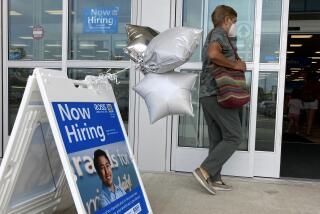Survey of Purchasers Says Economy Retreating
- Share via
NEW YORK — The economy pulled back a bit in March, after improving during the first two months of the year, the National Assn. of Purchasing Management said Sunday in its monthly report.
Another report, meanwhile, from Dun & Bradstreet Corp., said the nation’s business leaders are more optimistic about the outlook for sales, profits and employment despite forecasts of slower economic growth in 1985.
The purchasing managers’ composite index--a leading, or forward-looking, indicator--fell for the second consecutive month, the association said.
New orders dropped slightly in March after a healthy increase in February. Inventory levels declined, mirroring a similar drop in production, the group said.
The speed of vendor deliveries was about the same last month as in February and employment improved slightly, it said.
For the fourth consecutive month, managers reported more price decreases than increases, it said.
And in answer to a special question, 40% of the managers said the first quarter fell below their expectations, while 18% said it exceeded them.
“Although the economy performed well in the first quarter, we must be concerned with the drop in the purchasing managers’ composite index. The leading indicator should be watched closely in the months ahead,” said Robert J. Bretz, director of corporate purchasing for Pitney Bowes Inc. and chairman of the group’s business survey committee.
The seasonally adjusted index fell to 47.7% in March after slipping below 50% to 49.7% in February. Last month’s level was the lowest since the index registered 46.9% in January, 1983. A reading below 50% indicates that the economy is in a declining phase, while reading above indicates a rise.
The monthly report is based on replies to various questions asked of purchasing managers of 250 industrial companies.
A more optimistic reading was released Friday in Washington by the Commerce Department, whose index of leading indicators for February posted a strong 0.7% gain despite slowdowns from severe weather.
The index, composed of a dozen forward-looking business statistics, had been signaling weaker economic activity since June until it jumped 1.5% in January, its best showing in 17 months. The performance in January and February prompted Administration officials and private economists to predict a rebound in economic activity in coming months.
The Commerce Department’s index measures a broader range of economic indicators, while the purchasing manager’s index is keyed to the industrial sector.
In another report released Sunday, Dun & Bradstreet said second-quarter business expectations increased for sales, profits, inventories, employment and new orders compared with expectations for the first quarter. The finding was based on a survey of 1,400 executives.
Business optimism, which reached a record high in the third quarter of last year, decreased in the fourth quarter of 1984 and in this year’s first quarter, the business information company said.
Joseph W. Duncan, corporate economist for Dun & Bradstreet, said the current increase in optimism was prompted by the strengthening in the economy in the fourth quarter.
“Moreover, I think the federal government has shown that it is determined to deal with the deficit, which is easing concerns over a potential credit crunch,” he said.
More to Read
Inside the business of entertainment
The Wide Shot brings you news, analysis and insights on everything from streaming wars to production — and what it all means for the future.
You may occasionally receive promotional content from the Los Angeles Times.










